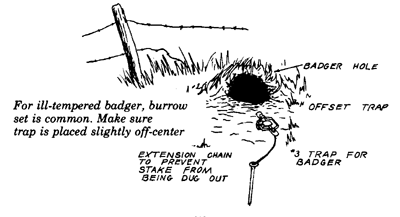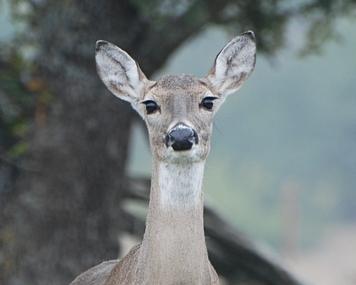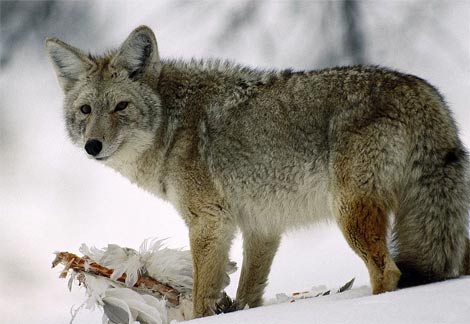Coyotes may respond to predator calls. Calling, like other methods of predation control, should be used sparingly and only when needed. Coyotes can be called at any time of the day although the first couple of hours after dawn and the last few hours before darkness are usually best. Call in areas where there are signs of coyotes, such as tracks or droppings. Continue reading Calling and Shooting Coyotes
About the Grizzly Bear
Although wildlife management concepts have been around, bears and their management have been poorly understood to date. Recent concern for the environment, species preservation, and ecosystem management are only now starting to affect the way we manage grizzly bears (Ursus arctos). By the way, Grizzly bears are the same as brown bears.
The difficulty in understanding brown bear biology, behavior, and ecology may have precluded sufficient change to prevent the ultimate loss of the species south of Canada. Grizzly bears must be managed at the ecosystem level. The size of their ranges and their need for safe corridors between habitat units bring them into increasing conflict with people, and there seems to be little guarantee that people will sufficiently limit their activities and land-use patterns to reduce brown bear damage rates and the consequent need for damage control. Drastic changes may be needed in land-use management, zoning, wilderness designation, timber harvest, mining, real estate development, and range management to preserve the species and still meet damage control needs.
Trapping Badgers Using Live Traps
Badgers are strong animals that can cause a lot of damage. They can den under homes and buildings and create problems for residents. The successful trapping of badgers can eliminate or prevent these problems. Badgers can be removed by using live traps and/or foothold traps set like those for coyotes. Snares have been used with mixed success, but they can be effective in the right situations.
Badgers often return to old diggings, so this is always a great place to trap. A good bait for badgers is a dead chicken placed within a recently dug burrow. Fur trapping may reduce badger populations locally, but badger pelts are generally of little value and most badgers are caught incidentally.
Foothold traps in the sizes #3 or #4 are adequate to hold even a large badger. However, rather than staking the trap to the ground, it is better to attach it to a drag such as a strong limb or similar object that the badger cannot pull down into its burrow. The problem with stationary stakes is that badgers will often dig in a circle around a stake, sometimes enough to loosen the stake and drag the trap away.
Badgers are neat animals when living in their natural habitat, but removal through trapping is sometimes necessary for both the badger and people. Before trapping, I recommend trying to “bother” the badger with enough activity to push the animal out of the area. This can include the continuous playing of a radio close to their den or continual filling in of their den. This harassment may be enough to get the badger to leave the area and move off to better, more appropriate habitat.

Feral Hogs and Damage Concerns

Feral pigs can cause a variety of damage on both a small and large scale. The most common complaint is rooting or grubbing, resulting in the destruction of crops and pastures. Often times, pigs will damage crops immediately after planting or right as grains mature and are ready for harvest. Damage to farm ponds and watering holes for livestock is another common problem, as land contouring and reconstruction is expensive. Predation on domestic stock and wildlife has been a lesser problem in North America, but has been found in some instances. Continue reading Feral Hogs and Damage Concerns
Setting Snares for Coyotes
Snaring is the technique of setting a steel-cable loop in an animal’s path to capture it by the neck, body, or leg. Snares usually consist of a 2.5- to 10foot (0.75- to 3.0-m) long piece of galvanized aircraft cable containing a slide lock that forms a loop in the cable (Fig. 31). On short snares, a swivel to prevent twisting and breaking the cable is attached to the end of the cable opposite the loop. On longer snares, swivels can be located near the middle of the cable and at one end. Continue reading Setting Snares for Coyotes
Contraception to Control Deer Numbers

Promising research on the use of chemosterilants and immunocontraception to reduce or eliminate reproduction in white-tailed deer is underway. Specificity, efficacy, and delivery of contraceptive agents to deer, however, continue to be problems. The use of contraception for deer herd control will be best suited to urban parks, refuges, and other discrete areas. Keep in mind that deer repellents only treat the symptoms of the problem, but will not control the increase in population size.
It is unlikely that contraception can or will be applied in rural and agricultural areas because of the flow of animals in these large areas. However, these areas also received a high value of economic damage caused by deer depredation of crops and ornamental plants. In these areas, fencing and or deer control fencing will be necessary to keep deer numbers and crop damage depressed.
Repelling Coyotes

Coyotes rely heavily on visual cues while stalking, chasing, and killing their prey. Taste and smell are of lesser importance in actually making the kill. These factors may in part account for the fact that the repellent compounds were not able to consistently prevent coyotes from killing, although some of the repellents were obviously offensive to coyotes and prevented them from consuming the killed prey. Several compounds were tested on sheep under field conditions, but none appeared to offer significant, prolonged protection.
If an effective chemical repellent were to be found, the obstacles in bringing it to industry use would be significant. The compound would not only need to be effective, but also persistent enough to withstand weathering while posing no undue risk to the sheep, other animals, or the environment. It would also have to withstand the rigorous Environmental Protection Agency (EPA) approval process.
High-frequency sound has also been tested as a repellent for coyotes, but the results were no more encouraging than for chemical repellents. Coyotes, like dogs, responded to particular sound frequencies and showed some aversion to sounds broadcast within one foot of their ear. Researchers, however, were unable to broadcast the sound a sufficient distance to test the effects under field conditions.
